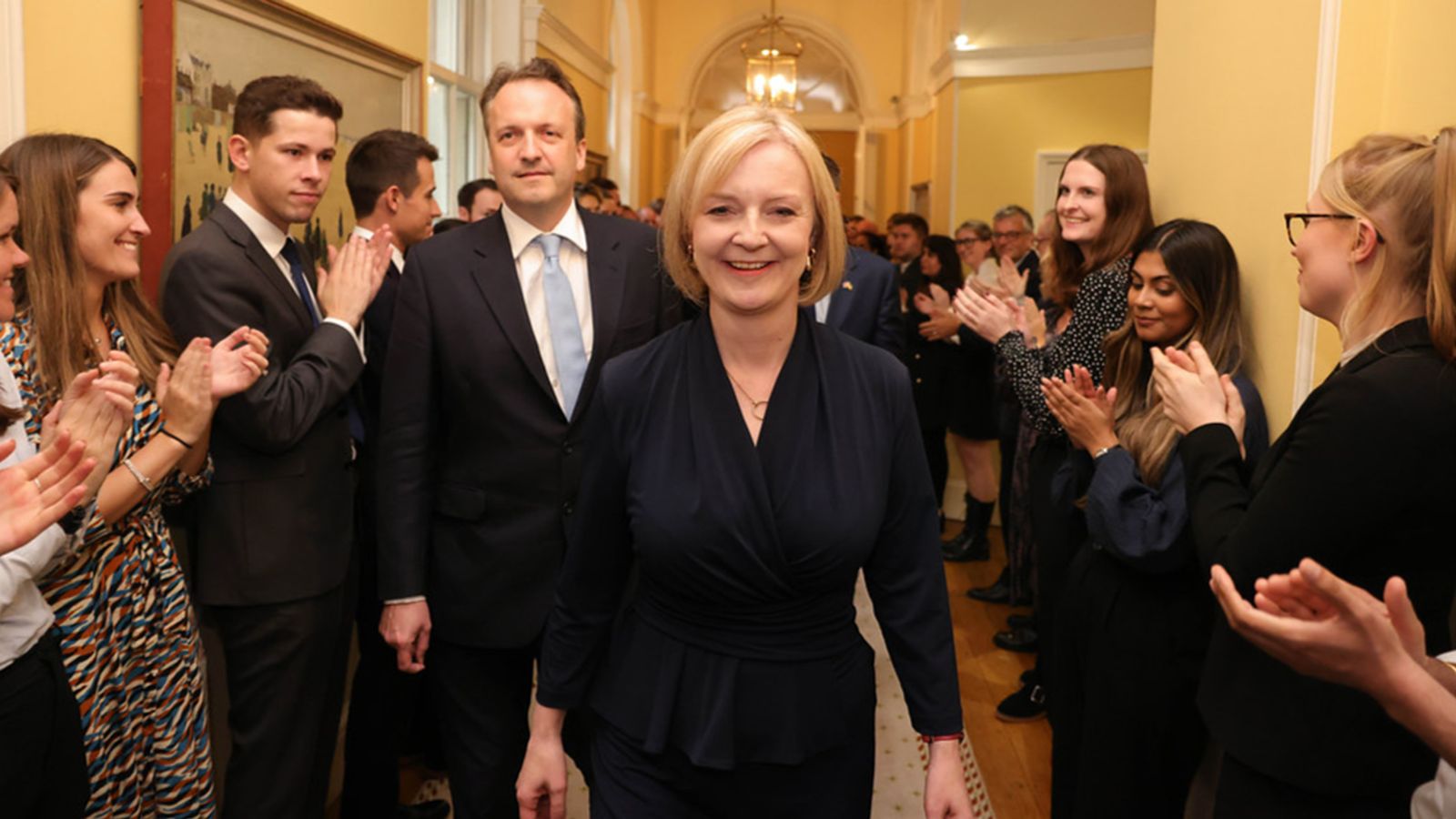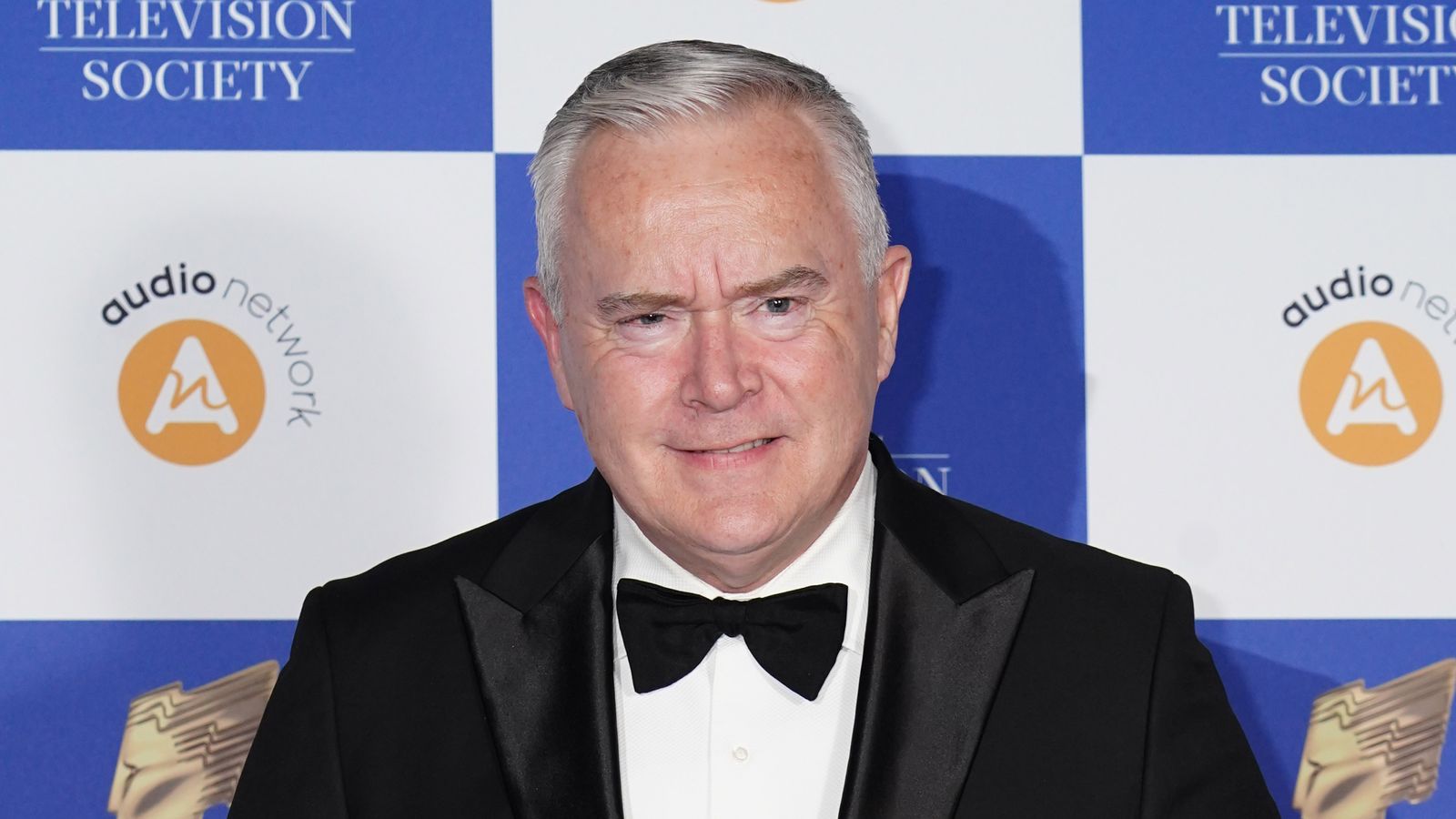Her opponents sometimes describe Liz Truss as continuity Boris Johnson.
But if her speaking style is anything to go by, the new prime minister really is a break from the past.
Her address to the nation was workmanlike, with none of the rhetorical flourish of her predecessor.
Truss outlines three priorities as PM as she selects her cabinet – live politics updates
She was concise, quick and clear as she set out her pitch to a sceptical country.
With the clouds threatening to open above her head, Ms Truss spoke of the stormy outlook she inherits.
But, in the style of tiggerish Mr Johnson, she tried to point to a brighter future, telling the public not be daunted about the challenges the country faces.
“As strong as the storm may be, I know that the British people are stronger,” she said.
“I am confident together we can ride out the storm.”
But the three priorities for her government that she outlined in her speech are each hugely daunting – economy, energy crisis and the NHS.
Please use Chrome browser for a more accessible video player
For the first, she promised tax cuts and reform to boost growth, with no reference to the impending protracted recession the Bank of England says we face.
On energy, the new prime minister promised action “this week” with the announcement on support for households and business set for this Thursday, as well as a longer-term programme to secure energy supply.
And her final priority, to fix a crisis in the NHS.
Three huge commitments in a perfunctory speech that promised much but revealed little of the plan.
And while Ms Truss used the opening of her address to pay homage to her predecessor, there was no doubt that she sought to cast her appointment as a brand new administration and a break from the past, despite her party being in power for the past 12 years.
But if she wants to turn a blind eye to the long incumbency of Conservative leaders in Downing Street, the public appears to have noticed.
The scandals of her predecessors, the long and ugly campaign, and failure to act on the matters that affect people’s lives on energy bills, public sector pay and the NHS is hurting the Conservatives, who are now trailing Labour by double-digits – a Survation poll this week gave Labour a 46-29 point lead over the Tories.
Please use Chrome browser for a more accessible video player
Ms Truss appears to be having a tough time with the public too, with polling by Opinium for the Observer over the weekend showing her ratings falling among 2019 Tory voters as the leadership contest went on.
Some 49% of people polled believed Ms Truss “looks like a prime minister in waiting” at the beginning of August, against 31% by the end of the month.
After her win on Monday, a snap YouGov poll found that only 14% of Britons thought Ms Truss would make a better PM than Mr Johnson.
It is a view shared by some of her colleagues, with one former cabinet minister – not of fan of Mr Truss or Mr Johnson – telling me over the summer that Ms Truss was “continuity Johnson without the charm”.
A party gripped by infighting, as a country is gripped by economic crisis and huge anxiety over energy bills and making ends meet, Ms Truss has but a small window in which to make her case to the British public.
Get it right, and she might buy some breathing space for her deeply challenged administration, get it wrong and it could seal the fate from her premiership in the opening weeks.
Make or break then. You can see why her allies are talking about a “shock and awe” moment on energy bills to show the public and businesses that Ms Truss is a prime minister who hears their concerns.
Please use Chrome browser for a more accessible video player
Details of Truss’s energy bills plan revealed
As a politician, she is ideologically low tax and small state and ran a campaign promising tax cuts and deregulation to boost economic growth.
She is a politician who believes it is wrong to look at economic policy through “the lens of redistribution” and thinks tax cuts for wealthy people are fair, while tax breaks for business will unlock investment and growth.
But weeks ago she appeared to resist the notion of a big package of support for energy bills, telling the Financial Times that “the way I would do things is in a Conservative way of lowering the tax burden, not giving handouts”.
Yet for all the red meat she dished out of Conservative Party members during the leadership race, she will within 48 hours of becoming PM set out a huge package of government support for households and businesses that will run into tens of billions of pounds.
I understand from a source familiar with the plans Ms Truss is looking at a cap on the price of wholesale gas to address the cost of living crisis and support businesses.
Those close to the new prime minister say she wants a “bold” approach to show the public she hears their concerns.
There’s a lot of detail yet to be fleshed out. But we understand the cap is likely to be frozen at about £2,500, paid for by borrowing.
I am told they are confident this plan would cost less than the £100bn that has been suggested in recent days.
The significance of this is two-fold – it would help both businesses as well as households, and it would avoid a situation where the first act of the new PM would be to follow the course proposed by Labour leader Sir Keir Starmer (who has advocated freezing the energy price cap, which is the amount energy companies can charge customers).
But marry that with Ms Truss’s economic plan to cut taxes – restated on the steps of Downing Street – and there is a potential tension in her plans.
Her pledge to reverse the corporation tax rise and rise in national insurance to help fund the NHS and social care, promises that could cost £60-70bn on top of the energy commitments.
Please use Chrome browser for a more accessible video player
The conundrum facing new PM
This presents the new prime minister with a conundrum in which she will lift short-term borrowing has to rise to support homes and businesses through the energy crisis over winter while also promising to cut taxes, which will cost the Exchequer dearly too (the Sunak camp argued during the campaign that her promised tax cuts would amount to £60bn in lost revenue, although the Truss team dispute that, arguing tax breaks will boost economic growth).
Either which way, the markets and investors will want to be satisfied there’s a credible plan to repay back debt.
The risk is that billions on tackling energy costs while also cutting taxes will push up government borrowing, weaken the pound and further fuel inflation as the cost of energy and food imports rise.
The real risk, argues one Whitehall source, is that her plans could trigger an “existential threat” to a Conservative Party that has built its brand on the reputation of sound fiscal management.
“Her plan seems to just to borrow, borrow, borrow. If that is what’s she going to do, you might as well go full fat and just vote Labour,” the source said.
Because the spending pressure will come too from the NHS – her third priority.
As it heads to winter, the health service is in crisis.
Nearly one in eight people in the UK are waiting for care, while ambulances are taking nearly an hour on average to reach heart attack and stroke victims, while 12-hour waits at A&E have hit record levels.
Nurses and teachers are balloting to go on strike – and the backdrop could soon get worse not better as inflation puts further pressure on hugely stretched budgets for more investment, rather than reversing a tax rise – the NI rise – that was designed to put money into the NHS and social care pot.
And these policy differences matters too because of the shallow support Ms Truss has within the parliamentary party.
Truss in uncomfortable territory as ‘big beasts’ head to backbenches
The politics of her administration could prove another millstone around her neck.
For now, the Conservative Party will no doubt fall into line.
But the divisions over policy and splits over economic approach aired throughout the summer are not resolved and a tough winter with difficult choices is only likely to exacerbate those divisions.
As her detractors note, Ms Truss couldn’t even get over half of the parliamentary party to publicly back her – 41.7% of MPs have come out in support – even when she was nailed on to win.
So she begins the hardest run for any prime minister in over four decades, with the public backing of just 149 MPs out of 357 MPs.
Not comfortable territory for any prime minister, particularly when so many big beasts in the party – some potential enemies of Ms Truss – return to the backbenches.
Rishi Sunak, Michael Gove, Dominic Raab, Priti Patel, Steve Barclay, Grant Shapps are but a few of the prominent figures on the benches who have extensive experience of government and know their own minds.
Like Mr Johnson, Mr Truss has come into Downing Street with big promises to deliver. But she begins with neither the parliamentary nor public support he enjoyed when he first won his landslide. And all the while the economic storm clouds that built in those COVID years have become much darker still.
Clear promises, but whether she can deliver them a much murkier call.








